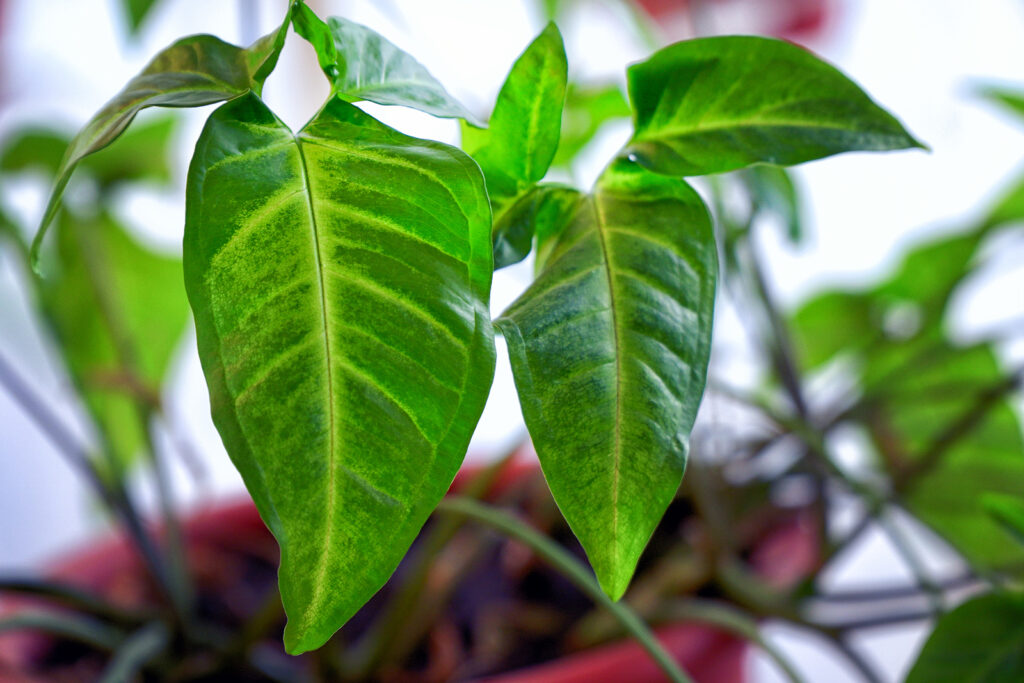Syngonium, sometimes called arrowhead vine, is a tropical climbing or trailing vine with fleshy stems that grow to 6 feet (2m) or more tall. Lovely, arrow-shaped leaves may be green or variegated and from 3 to 12 inches long.
Syngonium leaves change shape as the plant matures; young plants are solid and triangular, the leaves on older plants become deeply cleft forming from three to nine leaflets.
Syngonium can be grown as a houseplant supported by a stake or in a hanging basket. In tropical regions, it can be grown outdoors as a groundcover or climbing plant to cover a wall.
Syngonium is a genus of 33 species of evergreen climbers native to tropical Central and South America.
Get to know Syngonium
- Plant type: Tropical trailing or upright evergreen perennial
- Growing Zones and range: Zones 10-11
- Hardiness: Tender
- Optimal growing temperature: day 70°F (21°C), night 55°F (13°C)
- Light: Medium to bright indirect light
- Height and width: 3 to 6 feet (1-2m) tall
- Foliage: Arrow-shaped leaves on long stalks to 12 inches (30cm) long; vining stems can grow to 15 feet (4.5m) long
- Use: Houseplant, hanging baskets
- Common name: Syngonium, Nephthytis, arrowhead vine
- Botanical name: Syngonium podophyllum
- Family: Araceae
- Origin: Tropical Central and South America
Where to plant Syngonium
- Light outdoors: Plant Synogonium om dappled or partial shade.
- Light indoors: Grow Syngonium in medium to bright indirect light.
- Soil outdoors: Plant Syngonim outdoors in fertile, moist soil
- Soil indoors: Grow Syngonium in an all-purpose potting mix. Give the plant a wooden slab to climb.
How to water and feed Syngonium
- Water Syngonium to keep the soil evenly moist—less moist in winter.
- Fertilize Syngonium 2 to 3 times in summer when growth is active.

Syngonium care
- Prune Syngonium frequently to promote the growth of young leaves.
Growing Syngonium as a houseplant
- Give Syngonium bright light, a warm temperature, and medium to high humidity.
- Water moderately and allow the soil to dry between waterings.
- Fertilize Syngonium regularly in spring and summer.
Syngonium common problems
- Mealybugs and spider mites can be a problem. Knock pests off with a strong spray of water or spray plants with insecticidal soap.
- If growth is spindly, move the plant into more light.
- Leaf markings tend to fade as the plant grows older.
Syngonium propagation
- Propagate Syngonium from cuttings.
Syngonium varieties to grow
- Syngonium auritum. Trailer or climber; grows to 10 feet tall; arrow-shaped glossy mid to deep green leaves.
- S. erythrophyllum. Climber grows 6 to 10 feet talll dark green leaves; green and white spathes.
- S. macrophyllum. Cliber with ovate mid-green leaes grows 6 to 10 feet tall.
- S. podophyllum, arrowhead vine. Climber or trailing grows 3 to 6 feet tall; arrow-shaped leaflets, dark green above. Several cultivars: some cultivars have solid green leaves, others have pale yellow or creamy veins, others have white or gold speckles.



